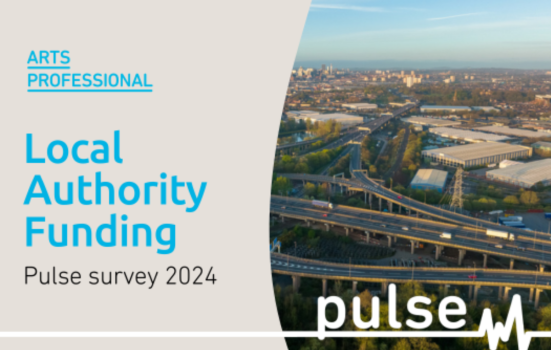Council cuts to arts budgets have left charitable trusts and foundations 'overwhelmed' with applications for funding as arts and culture organisations attempt to source alternative income.

Arts organisations are turning to trusts and foundations to plug funding gaps caused by local authority cuts to arts spending leaving them "overwhelmed", Arts Professional's latest Pulse survey has found.
With more than two-thirds of local authorities cutting or planning to cut the amount they spend on arts and culture, 57% of survey respondents said they had applied for funding from trusts and foundations in response to reduced council funding, with 43% succeeding.
Several survey respondents commented that the pressure on trusts and foundations was becoming “unsustainable”, causing the funding landscape to become “increasingly difficult” for arts organisations to navigate.
READ MORE:
One respondent said: "We are consistently told to find alternative sources of funding. Trusts are overwhelmed and stuck in a model where the organisation can fill funding shortfalls if the budget is not secured.
“There is much more competition for already oversubscribed trusts & foundations now, and we're feeling the struggle. Trusts and foundations have been changing their response times, which greatly impacts project timelines,” they added.
Another respondent noted that some significant trusts were also changing how they operate or ending their grant-giving programmes, which was having a knock-on effect.
"Charities are being left to pick up the gaps from cuts in local authority funding already," they said.
"How can this be sustained?"
'Huge impact on emerging artists'
Concern raised by respondents have been confirmed by trusts and foundations that fund arts organisations.
Henry Moore Foundation (HMF) Grants Manager Chloe Parratt told Arts Professional that the organisation had seen a rise in the number of councils and council-run venues applying for funding, with “record-breaking” demand already this year.
Over the last two years, Parratt said general requests for funding to HMF had increased with around 30-50% more applications per quarter, comprising both eligible and non-eligible applications.
Of those that are eligible, Parratt said that in 2023 HMF received requests for support to the value of £2.71m, compared with £2m in 2022 - a rise of 35.5%.
So far this year, HMF has already received £ 1.97 m of eligible requests and is predicting £3.8m for 2024, its highest total ever and almost double that of two years ago.
Speaking about the effect on the sector, Parratt said: “We have also seen more projects cancelled, especially if applicants do not receive their full request, because external funding is now integral to the budget, rather than venues having a central budget to draw down from.
“This means that fewer artists are having a chance to be shown which could have a huge impact on new emerging artists.”
Filling a hole in centralised budgets
Belgae Trust also told Arts Professional that they had experienced an increase in requests, with more than 50% of the applications in its last round coming from arts organisations.
Founded in 2016, the trust supports a range of causes within the Hampshire area. With a £132m budget shortfall expected by April 2025, Hampshire County Council is one of several in the UK making drastic cuts to its arts services, including a 50% cut in its support of Hampshire Cultural Trust.
Jan Church, a Trustee at Belgae, said some of the requests driving the demand were from organisations previously funded by the council that had been “told to look for funding elsewhere” and that during discussions over grant allocations, some of the trustees felt strongly that the trust was “not in the business of filling a hole in centralised budgets.”
Church said: “As a small family charity, we were certainly overwhelmed by applications from very worthwhile local arts and culture groups (theatres and music organisations), which we were sadly unable to give to.”
Unprecedented demand
David Hall, CEO of Foyle Foundation, said the organisation, which supports arts, learning, communities and state school libraries, had also encountered “unprecedented” numbers of new applications since January of this year, steadily rising since late last year.
The foundation was established in 2000 without a permanent endowment requirement. In January, it announced that it would complete its grant-giving programme in 2025 after distributing more than £146.6m over 25 years.
Hall attributed the “deluge” in applicants mainly to the programme's culmination, noting that since January, requests to Foyle Foundation had doubled. He added that the foundation received applications mentioning cuts in local authority funding as a factor, though not many more than in previous years.
However, Hall suggested this may change in the near future, as “many are indicating that they are forecasting reduced or no local authority funding, and therefore, are more actively fundraising.” He added that last year's inflationary spike was also driving arts organisations to apply for more external funding.
The “massive upsurge” has put a strain on the foundation, according to Hall, resulting in longer working hours for staff and an increase in their grants budget. “Even so, we are under pressure,” said Hall, “and this will be a very competitive year to receive funding from the Foyle Foundation.”
Shifts in strategy
While every foundation or trust Arts Professional spoke to had recently encountered elevated funding requests from arts organisations, several factors were cited other than, or in addition to, council cuts.
A spokesperson for Jerwood Foundation said that although they experienced an “overwhelming” response to their spring funding round, this was primarily due to the recent merger of its two charities, which simplified the application process. They added that council cuts likely also contributed to the rise but said it would be difficult to quantify the impact accurately.
Meanwhile, a spokesperson for the Esmée Fairbairn Foundation said that while demand for funding from the arts sector remains very high, it has not seen a specific rise in reaction to the cuts to local authority funding.
“Changes in our application numbers reflect shifts in our strategy and the guidance we give for applicants, as well as when we have been open or closed to applications. We are always looking to cut down the number of unsuccessful applications in order to save the time taken to write them.
"Our arts funding is now focused on diversifying the cultural workforce, supporting youth-led creativity and funding community-led art and creativity.”




